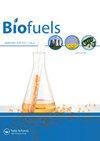不同无机酸处理HNbMoO6超强酸对甲基酯化反应的催化活性及表征
IF 2.6
4区 工程技术
Q3 ENERGY & FUELS
引用次数: 0
摘要
摘要采用不同浓度的酸(HNO3、H2SO4、H3PO4)分别在2、4、6 mol L−1条件下处理前驱体LiNbMoO6,合成超强酸HNbMoO6。对所得到的固体进行了表征,以阐明其组成、酸度和性质。无论所用的酸类型和浓度如何,材料都呈现出相似的衍射模式和光谱。显微镜分析表明,在较低浓度的酸下,观察到较低的晶体团聚。x射线能谱分析结果表明,以h2so6 6 mol L−1合成的HNbMoO6具有最高的Nb5+/Mo6+比(1.95)、最高的比表面积(8.53 m2 g−1)和最高的Lewis酸度(1.5 mmol正丁胺)。所有固体在月桂酸甲酯化反应中都是有效的,反应后没有发生结构变化。用h2so6 6 mol L−1处理HNbMoO6的效果最好,在月桂酸甲酯中转化率高达81.79%,与热转化相比,催化增益为36.82 p.p。图形抽象本文章由计算机程序翻译,如有差异,请以英文原文为准。
Catalytic activity in methyl esterification reactions and characterization of the superacid HNbMoO6 treated with different inorganic acids
Abstract The superacid HNbMoO6 was synthesized from the treatment of the precursor LiNbMoO6 with different acids (HNO3, H2SO4, or H3PO4) in the concentrations of 2, 4, and 6 mol L−1. The solids obtained were characterized to elucidate their composition, acidity, and properties. The materials presented similar diffraction patterns and spectra regardless of the acid type and concentration used. The microscopy analysis showed that at lower concentrations of acid, lower crystal agglomeration was observed. The results of the energy-dispersive X-ray spectroscopy indicated that HNbMoO6 synthesized with H2SO4 6 mol L−1 had the highest Nb5+/Mo6+ ratio (1.95), besides the highest surface area among the synthesized solids (8.53 m2 g−1), and highest Lewis acidity (1.5 mmol of n-butylamine). All solids were efficient in the methyl esterification of lauric acid and did not undergo structural changes after the reactions. The best result was obtained with HNbMoO6 treated with H2SO4 6 mol L−1, with a high conversion rate of 81.79% in methyl laurate, an expressive catalytic gain of 36.82 p.p in contrast to the thermal conversion. Graphical Abstract
求助全文
通过发布文献求助,成功后即可免费获取论文全文。
去求助
来源期刊

Biofuels-Uk
Energy-Renewable Energy, Sustainability and the Environment
CiteScore
5.40
自引率
9.50%
发文量
56
期刊介绍:
Current energy systems need a vast transformation to meet the key demands of the 21st century: reduced environmental impact, economic viability and efficiency. An essential part of this energy revolution is bioenergy.
The movement towards widespread implementation of first generation biofuels is still in its infancy, requiring continued evaluation and improvement to be fully realised. Problems with current bioenergy strategies, for example competition over land use for food crops, do not yet have satisfactory solutions. The second generation of biofuels, based around cellulosic ethanol, are now in development and are opening up new possibilities for future energy generation. Recent advances in genetics have pioneered research into designer fuels and sources such as algae have been revealed as untapped bioenergy resources.
As global energy requirements change and grow, it is crucial that all aspects of the bioenergy production process are streamlined and improved, from the design of more efficient biorefineries to research into biohydrogen as an energy carrier. Current energy infrastructures need to be adapted and changed to fulfil the promises of biomass for power generation.
Biofuels provides a forum for all stakeholders in the bioenergy sector, featuring review articles, original research, commentaries, news, research and development spotlights, interviews with key opinion leaders and much more, with a view to establishing an international community of bioenergy communication.
As biofuel research continues at an unprecedented rate, the development of new feedstocks and improvements in bioenergy production processes provide the key to the transformation of biomass into a global energy resource. With the twin threats of climate change and depleted fossil fuel reserves looming, it is vitally important that research communities are mobilized to fully realize the potential of bioenergy.
 求助内容:
求助内容: 应助结果提醒方式:
应助结果提醒方式:


